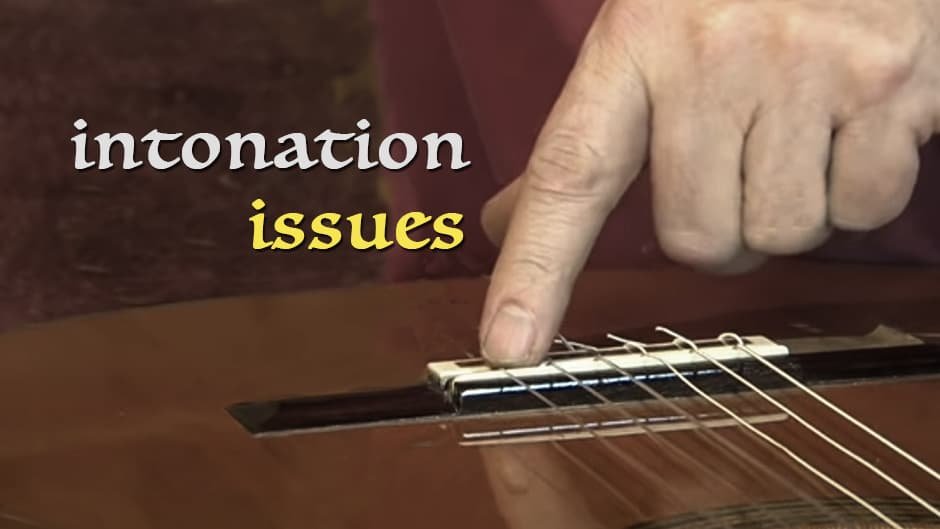As a classical guitar player, you will sooner or later hear of intonation issues. Or you get to face them yourself. They crop up fairly often in forum discussions, although some folks can only discuss them using a lot of science and math!
What exactly does it mean to have an intonation issue? Intonation has to do with a guitar being in tune across all frets on the fingerboard, not just the open strings. If the open E note on the first string sounds exactly the same as the fretted E note on the 12th fret (although an octave higher) then that string is in tune. If the sounds mismatch with one of them sounding flatter or sharper than the other, that string has an intonation issue.
Intonation at a manufacturing level and at the highest performance level is a complex issue that has been gaining attention in recent years. There are actually technical papers written by luthiers and others on intonation, full of ratios, micro measurements and rocket science. To be fair, it is an important subject for today’s luthiers who are required to make instruments of consistent quality and also for advanced players, including concert artists, who take the issue of tuning pretty seriously.
Let’s figure out how to identify if your classical guitar has any intonation issues at all. We will ask why and understand where they came from. And then take some concrete action to solve them.
Do you have an intonation issue and does it matter?

Do this test.
Play the open first string. Use a trusted electronic tuner to make sure it is exactly the E note. Go to the 12th fret of the same first string and play a harmonic there. Your tuner should (ideally) show an exact E note again. Now fret the first string at the 12th fret normally and play the note. Take care not to bend the string. Is the tuner still saying E – neither a cent too high or too low? If the three readings are the same, you do not have an intonation problem on the first string.
Do this test on the other five strings. It is not at all uncommon to find tuner reading differences. The 12th fret notes may be sharp or flat at least on a couple of strings.
Now do this test.
Making sure the open E string (first string) is in tune, fret the first string at the 7th fret and play. Check the tuner for an exact B note reading. Note if it’s off, whether sharp or flat and by how much. Repeat this test on each string and see if you’re getting the following exact notes and if not, note the extent of the discrepancies.
2nd string – 7th fret – F#
3rd string – 7th fret – D
4th string – 7th fret – A
5th string – 7th fret – E
6th string – 7th fret – B
Many guitarists are surprised to find that in a number of places on the fretboard their guitar’s intonation is less than perfect. The G string is often the culprit, going sharp from the 7th fret upwards. Your results may vary.
If you find intonation issues, what then? A beginner in their early years of playing will not even be playing higher up the fingerboard. Almost all the pieces they play will be in the first two or three positions. They really shouldn’t bother about solving intonation issues.
This is a practical suggestion if only because cheaper beginner guitars tend to exhibit intonation issues almost always. If you are a beginner, you can worry about the issue when your playing takes you to a more advanced guitar. Till then, relax.
Also, the common-sense solution for most players is to consider if these issues are only perceived when using a tuner. If you couldn’t tell much of a difference with your ears – the tonal differences are often tiny, except in drastic cases when they aren’t! – you can go about the business of learning the guitar without losing sleep over the issue.
If the tonal difference is drastic or you were already troubled by the notes played higher up the fretboard with the tuner readings only confirming your suspicions, you can’t ignore the issue. The fact is many guitars, even the famous models from well known names, do not play in tune on every fret on every string.
We will look at possible solutions below. Which solution is right for you depends on what caused the intonation issue in the first place.
Why does it happen?
The issue has to do with the relationships between the nut, the 12th fret and the saddle and the action. That is another way of saying the responsibility for the issue lies with the manufacturer.
The exact location of the saddle, the action height and the strings used also affect intonation. Basically, when you push a string down onto a fret you stretch it a bit, and it tends to go sharp. How much sharp depends on how far down you have to push it, and how stretchy the string is. Nylon strings stretch quite a bit in contrast to steel strings.
Even with all such manufacturing and design factors under control, a good classical guitar may face intonation issues under the following circumstances:
- The strings are old (no wonder the tuner is acting weird!)
- The strings are from a poor quality batch
- Strings are other than what the manufacturer recommends for the guitar
- High tension strings that don’t take to your guitar well
- A guitar with its action re-adjusted (typically, the saddle is raised or lowered)
Any of the above can cause intonation issues. For instance, I bought my luthier-made Amalio Burguet at their factory in Valencia, Spain. As I was leaving the premises, one of the last things the salesperson told me was to never use high tension strings on it. Only normal strings, only normal tension strings, please.
In my related article on How to Find Your Perfect Set of Classical Guitar Strings, I talk about using a 5-step guide over an extended period of time to arrive at your favorite set. Many brands are explored, many exciting materials like carbon, titanium and Nylgut are discussed. In that happy journey, we end up with not only a set or two of strings we absolutely love but also some intonation issues.
Besides, your guitar – not just the strings on it – may be getting old. All guitars age and some of that aging shows up in the neck which warps, corkscrews or bows. The frets wear out along with the bridge and nut, too. Normal maintenance of an aging guitar requires the occasional trip to the guitar factory.
Solutions at hand
Solution 1: As mentioned earlier, do nothing. Ignore the issue. Why? Because your playing rarely takes you to the higher frets. Or yours is a cheap beginner guitar that you will outgrow soon. You really don’t want to make expensive luthier shop repairs if the tonal differences do not bother you currently.
Solution 2: One of the best and cheapest solutions is to experiment with different strings. Put on new strings. Try strings by different makers. Try alternative tensions (unless the manufacturer doesn’t recommend them). If G string is the problem, try a wound G rather than the usual unwound G string. I recommend my piece Try Carbon Strings for Your Guitar to learn the crucial details about carbon over nylon strings.
Always check for intonation issues if you change into a different tension or a different material like carbon, titanium, etc. Trying out new strings is an important suggestion. Before you spend a lot of money on luthier repairs, you must know that some brands of nylon strings intonate much better than others.
Solution 3: Once the strings issue is resolved to their satisfaction, some players use the approach of tuning to “average out” the intonation problem. Instead of tuning the open string, they tune each string to a tuner at its 5th fret. You may find the problem has been reduced sufficiently for you to live with it.
Solution 4: If you’re a wood worker or comfortable with DIY tools and such, you may wish to immerse yourself into the technicalities of the subject. Read up on Doolin’s informative article in American Lutherie Issue 92 at www.luth.org as well as Greg Byer’s article at www.byersguitars.com.
You will understand that guitar making at its most basic is a set of compromises and adjustments when it comes to intonation. You will understand the concept of ‘compensation’. Intonation is determined by the relationship of the nut to the 12th fret and the 12th fret to the saddle. These proportions of the lengths of the string must be essentially equal, with slight adjustments known as compensation that varies according to string tension and material as well as the action and scale length.
You will most likely be making saddle intonation adjustments like the kind in the video below. Basically, you are taking matters into your own hands. There is a lot of information available on the net if you’re going down this path.
Saddle intonation video
In this solution, you get your guitar set up with the strings you want to use, and the action you like. You can figure out how much compensation it will need to play in tune, and you can figure out how much work that’s going to entail.
Solution 5: If nothing above is workable or if your guitar is expensive, take it to a good luthier. There are many refinements that are possible that a skilled luthier is well equipped for. He or she can make adjustments at the saddle or whatever else it takes. There are a few tricks to try: like straightening the neck, redressing the frets, resetting or replacing worn nuts and bridges. All this is normal wear and tear stuff on old guitars especially. And it’s truly amazing what a good luthier can do to get a guitar going on full swing once more.
A luthier will try and compensate for the intonation based on a few considerations:
- Higher the action, more compensation is needed
- Shorter the scale length, more compensation is needed
- Thicker strings (like basses) will need more compensation
And so on.
_________________
One of the reasons for intonation issues, as we’ve seen, is old strings. To understand how long is the life of a new set of strings, read my article How Long Do Nylon Strings Last?
Related topic: Why does the G string sound so bad? Read this article to understand why it happens and what you can do about it. To elicit a better tone from your guitar generally, you need to take good care of your nails – read my tips at Nail Care Tips and Products.
Happy tuning!


This is a great article. Thanks for the information.
I also found this video on youtube to be very helpful to explain/fix intonation issues: https://www.youtube.com/watch?v=bI9ZrcF9xzg
Very helpful advice! My brand new high e string had intonation issues until I replaced the string for an older one, it worked!
Great to hear that.